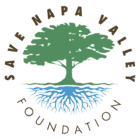Rich Marovich, Water Audit California
Download
Thirteen waterways in Napa County once supported Central California Coast Steelhead at population densities of greater than one fish per square meter. Steelhead populations show evidence of decline in all thirteen waterways (Leidy et al 2005). In 1997, the National Marine Fisheries Service (NMFS) listed Central California Coast steelhead as a distinct evolutionary unit that is threatened with extinction.
NMFS and the Napa Resource Conservation District (NRCD) consider artificial fish barriers to be the major cause of decline. Fish barriers prevent steelhead from accessing spawning and rearing habitat necessary to complete their life cycle. The California Department of Fish and Wildlife (DFW), NRCD and Water Audit California (WAC) have surveyed Napa waterways identifying 130 natural and artificial barriers about 30 of which have been removed or are in process of being removed. About half of the barriers are natural limits offish migration. Of the remaining 50 barriers, 30 occur in prime steelhead habitat.
WAC and NRCD are currently focused on remediating six of these barriers that would collectively restore access to 5.8 miles of steelhead spawning and rearing habitat. Some of these fish barriers have been known for over 20 years and progress toward remediation has been slow and expensive. There is a tendency to overengineer and overregulate solutions. When the cost of permits greatly exceeds the cost of remediation, projects languish. DFW introduced a permit streamlining process to allow restoration projects to be fast-tracked. WAC is using the first six barrier remediation projects to test the permit streamlining process. WAC hired Streamwise, a stream restoration company with over 20 years of stream restoration projects to develop site plans for the first six projects. The site plans make the projects actionable with relatively simple and cost-effective remediation methods using boulders to create fish passage through otherwise impassible barriers. The boulders are strategically placed to back the water up through culverts and other obstructions allowing fish to pass. The first six projects have a combined construction cost of $160,000 excluding permitting and biological monitoring costs.
WAC intends to create a protocol to address the remaining 24 barriers in Napa County that affect prime steelhead habitat including remediation plans, permits and funding sources. WAC and NRCD convened a group of regulatory and resource agencies to discuss ways to streamline permitting approvals and funding for remediation. A site tour is planned for July 12. An unprecedented amount of public funding is available to remediate fish barriers but much of it could be wasted on excessive permitting and engineering studies, rather than implementing the simplest most cost-effective solution for fish passage.
WAC intends to replicate these methods of restoring fish passage in other counties.
2005. Leidy, Robert A., Becker, Gordon S. and Harvey, Brett N., Historical Distribution and Current Status of Steelhead/Rainbow Trout (Oncorhynchus mykiss) in Streams of the San Francisco Estuary, California. U.C. Berkeley.
